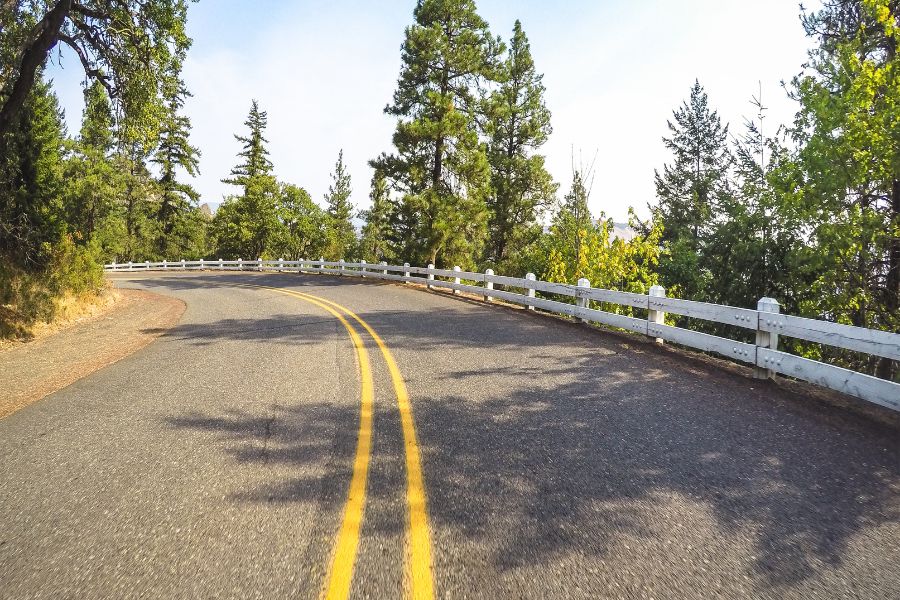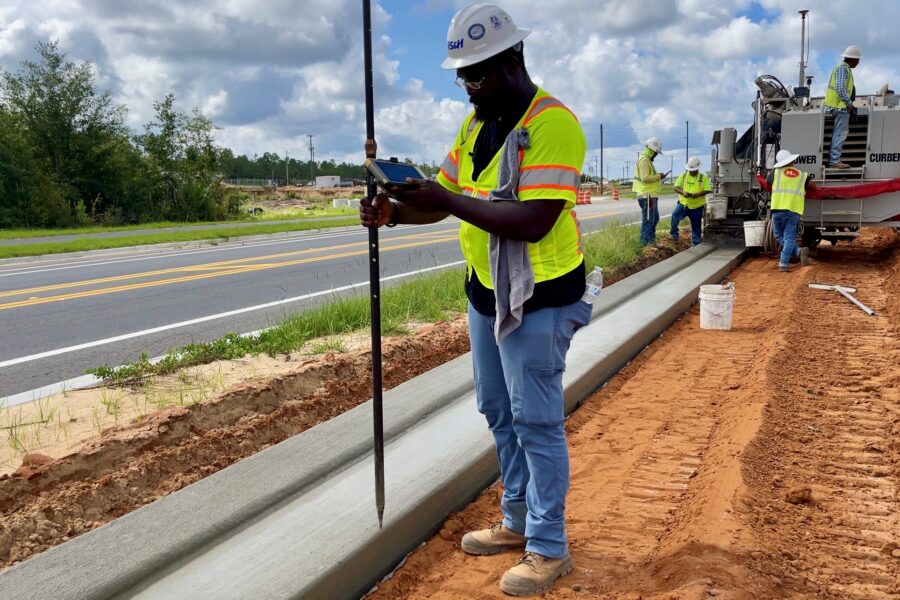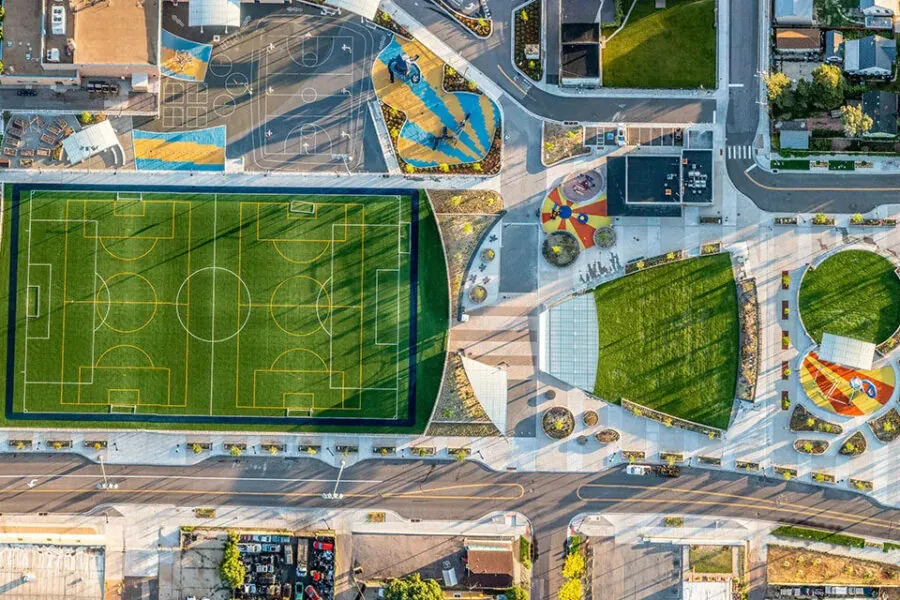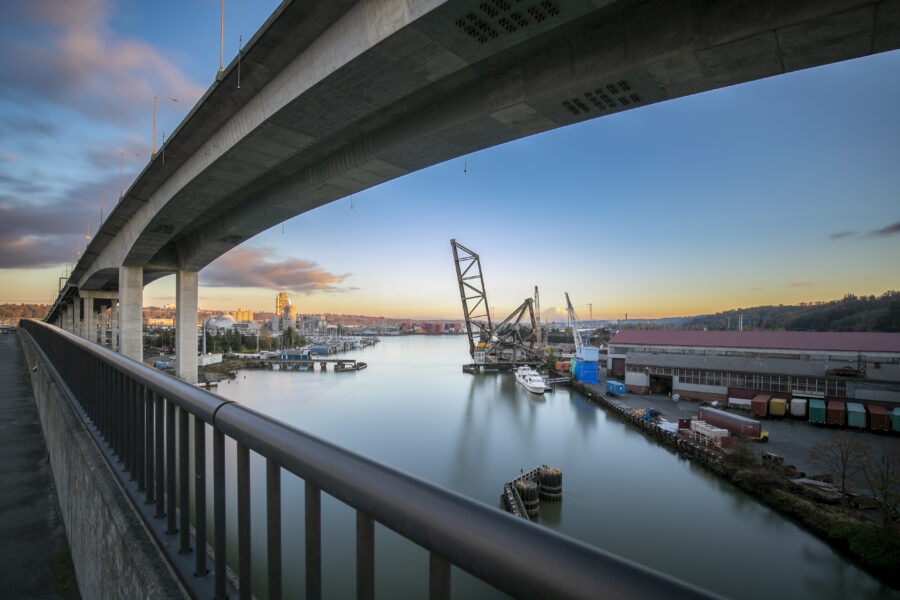2022 State of Transportation Report: Washington and Oregon

From increasing equity and reducing congestion to embracing emerging technology and active transportation, Washington and Oregon have a lot of infrastructure opportunities ahead.
This 2022 State of Transportation Report offers a look into some of the prominent challenges facing the transportation industry in these states and identifies emerging trends that are critical to the industry’s success.
3 Challenges Impacting the Oregon and Washington Transportation Industry
1. Cost Escalations
At the height of the COVID-19 pandemic, Oregon and Washington faced a dip in public transit ridership and toll use, which cut into revenue for project funding. While ridership and toll use are recovering to near pandemic levels, these states are now facing rising inflation and rising material costs.
According to data from the producer price index, the price of fuel increased by 174% in May 2022. Rising fuel costs make it more difficult for the Washington Department of Transportation (WSDOT) and Oregon Department of Transportation (ODOT) to afford their own fuel, and with fewer people driving and paying the gas tax, revenue is expected to shrink.
Increased fuel prices also have a correlation to increased materials costs. The cost of fabricated steel increased by 32.3% and asphalt has seen a 14% increase according to data from the producer price index. Supply chain issues are also adding to costs, as material delivery can be unpredictable, and suppliers cannot guarantee prices once materials are in stock. The increase in prices and dip in funding is causing state and local officials to reprioritize project needs and push back the start of some projects.
2. Labor Shortages
The Great Resignation, a term coined in the Spring of 2021, describes the record number of people who have left their jobs since 2020. The Great resignation has multiple root causes including people reevaluating their priorities during the COVID-19 pandemic and baby boomers retiring from the workforce. Whatever the cause, more people are leaving their jobs than can be replaced and the effects are widespread throughout the transportation sector.
In the second quarter of 2022, eighty-three percent of contractors are having trouble finding workers to fill the over 400,000 open skilled labor positions across the United States according to the Bureau of Labor Statistics. This leads to a lack of experience, support and staff available for projects. Labor issues also extended beyond job sites. Much of the supply chain issues stem from suppliers also not being able to fill open job positions. Labor shortages at any point in a project can raise costs and increase completion times.
Labor shortages are also affecting public transit. While ridership is growing closer to pre-pandemic levels, crew levels are not climbing nearly as quickly. Public transit users are facing reduced service as well as longer wait times. For instance, a worldwide shortage of mariners has caused disruptions in Washington’s state ferry service. This year, delayed sailings have hit an all-time high.
3. Declining Infrastructure Conditions
Much of our country’s infrastructure was built during the 1960s and 1970s, and it is now reaching the end of its lifespan. While routine maintenance can help extend the life of our infrastructure, preservation and management have sometimes not been a priority. Aging infrastructure raises concerns about delays and safety and can lead to negative impacts on the states’ economies. Declining conditions affect all variables of a transportation system from bridges and highways to public transportation. As of 2021, Washington has identified repairs needed on 6,894 bridges at an estimated cost of $17.2 billion. Oregon has identified 1,972 bridges for repair at an estimated cost of $3.4 billion.
3 Emerging Infrastructure Trends in Washington and Oregon
1. Equity
Increasing equity means looking beyond proposed improvements in the transportation system to analyze how they will affect communities. Equity goals focus on building a diverse workforce and community engagement which will help deliver authentic inclusivity.
In the coming months, we’ll see states begin to reevaluate their current recruiting and hiring procedures to create a workforce that is more reflective of the members of the community. Guidance will be established for interviews and job postings to ensure the process is accessible, transparent and fair. WSDOT has created a tangible Equity Lens guide that employees can refer to help them make more equitable and fair decisions around hiring and their project work.
Inclusive and thoughtful community engagement will play a vital role in ensuring equitable transportation policy and programs. While community engagement is required under federal law, states are building upon these laws to create robust community engagement plans. To increase community engagement, we’re seeing ODOT and WSDOT employees become active members of the community by meeting people where they are to understand priorities and perspectives. Online options for community engagement are also gaining popularity as they allow a greater reach to people affected by projects. Engagement with the community happens early and occurs at multiple points during projects. This allows community members to fully understand a project’s purpose and goals.
2. Multimodal Transportation
Multimodal and active transportation are top priorities for these states including improvements for highways, streets, roads, railroads, transit hubs, park-and-ride lots, bridges, sidewalks, bike lanes, ferry terminals, trails and safety projects.
There are many benefits of multimodal options which include:
- Providing people multiple options on how to get from point A to B, which increases transportation equity for the community
- Many multimodal options include active transportation- the transport of people or goods, through non-motorized means, based around human physical activity- which offers another sustainable option to help reduce emissions and pollutants that are affecting the climate
- More transportation options can lead to increased community connections, improving the quality of life for community members
As you can see in the chart below, Oregon and Washington are both ahead of the curve in the adoption of alternative and sustainable transportation options with people opting to commute to work by biking or walking. According to data from 2017, 6.3% of commuters went by bike in Portland, Oregon. That is the highest percentage of bike commuters for a large American city.
In 2023 we’ll continue to see a focus on multimodal transportation stemming from the recently passed Move Ahead Washington Package. This included a Complete Streets requirement which directs projects $500,000 or more to incorporate facilities that provide street access with all users in mind, including pedestrians, bicyclists and public transportation users.
Complete streets policies are an approach to planning that enables safe access to all users. There is not a single approach to complete streets, and a complete street may look different from community to community. A complete street may include sidewalks, bikes lanes, bus lanes, etc. depending on the need of the community. Complete streets make transportation options more equitable and safer.
Both The Oregon Pedestrian and Bicycle Program and the Transportation Options Program provide ODOT with resources to increase its multimodal transportation system. The goal of these programs is to spread awareness of transportation options while educating the community on how to safely use these options. these options.
3. Electrification
Transportation electrification will reshape the transportation system with a move from fossil-fueled powered personal cars, trucks and public transit to ones powered by electricity. The transportation sector accounts for 40% of greenhouse gas emissions in Oregon and 44% in Washington. Both states plan to expand electrification to combat the substantial number of emissions.
Though similar, each state has differing goals as they embark on increasing electrification. By 2035 Washington hopes to increase sales of zero-emission vehicles, including passenger cars, light-duty, trucks and medium-duty vehicles to 100%. Oregon hopes to triple the number of electric vehicles on the roads by the end of 2023.
While 80% of electric vehicle (EV) charging occurs at home, safe and reliable road options still need to be available. The National Electric Vehicle Infrastructure (NEVI) Formula Program, part of the Bipartisan Infrastructure Law (BIL), required every state to submit a plan for EV deployment. Washington and Oregon have both had their plans approved and are now able to access funds to strategically deploy EV charging infrastructure and create an interconnected network that supports data collection, access and reliability.
What to Expect for Transportation in 2023 and Beyond
Rising costs and labor shortages will continue to be an obstacle for Washington and Oregon as they look to repair aging infrastructure and expand their transportation networks. While these challenges will be significant there are opportunities to mitigate the effects. The original money from the BIL has helped fund maintenance and preservation projects and for many new projects, WSDOT and ODOT can take advantage of the increase in discretionary grant opportunities. As recruiting workers is becoming more of a challenge, these states can look to increase interest in the industry by partnering with schools. This is a tactic seen from Washington State Ferries as they have partnered with Seattle Maritime Academy to increase enrollment in hopes to fill the shortage of mariners.
The next few years will be tough, but the future state of transportation for these states looks optimistic. As a new year is approaching, Washington and Oregon have the opportunity to look deep into their projects and policies to understand the impact they will leave on their communities, and how they can work to create a sustainable transportation network that benefits everyone.
Additional resources, details, and information related to the Pacific Northwest Transportation Industry can be found below:
4 Tips and Best Practices to Secure Federal Grant Funding
Smart Growth America Complete Streets




